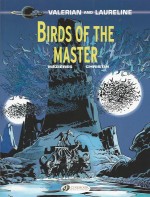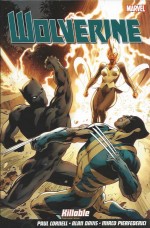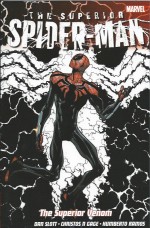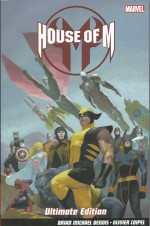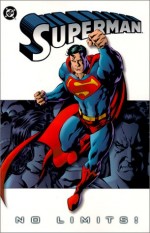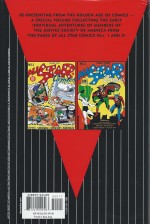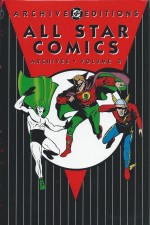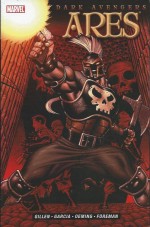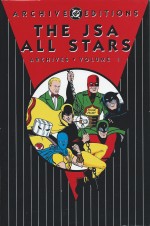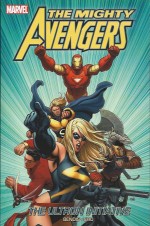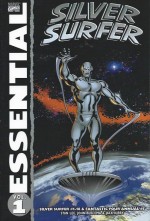
By Stan Lee, John Buscema, Jack Kirby & various (Marvel)
ISBN: 978-0-7851-2008-7
Although pretty much a last minute addition to Fantastic Four #48-50’s ‘Galactus Trilogy’, Jack Kirby’s scintillating creation the Silver Surfer quickly became a watchword for depth, allegory and subtext in the Marvel Universe and a character Stan Lee kept as his own personal toy for many years.
Tasked with finding planets for space god Galactus to consume, and despite the best efforts of intergalactic voyeur Uatu the Watcher, one day the Silver Surfer discovered Earth, where the latent nobility of humanity reawakened his own suppressed morality; causing the shining scout to rebel against his master and help the FF save the world.
In retaliation, Galactus imprisoned his one-time herald on Earth, making him the ultimate outsider on a planet remarkably ungrateful for his sacrifice.
The Galactus Saga was a creative highlight from a period where the Lee/Kirby partnership was utterly on fire. The tale has all the power and grandeur of a true epic and has never been surpassed for drama, thrills and sheer entertainment. It’s not included here: for that treat you’ll need to see Essential Fantastic Four volume 3 or many other Marvel collections…
In 1968, after increasingly frequent guest-shots and even a solo adventure in the back of Fantastic Four Annual #5 (thankfully included at the back of this tome), the Surfer finally got his own (initially double-sized) title. This occurred at the time when Marvel had finally escaped from a draconian distribution deal which limited the company to 16 titles per month.
That change resulted in a huge expansion in output which also saw Iron Man, Captain America, The Hulk, Sub-Mariner, Doctor Strange, Nick Fury and Captain Marvel all explode into their own titles.
This stunning and economical monochrome chronicle collects the entire 18 issue run of the Soaring Skyrider’s controversial first solo series as well as the aforementioned vignette from FF Annual #5 spanning November 1967 1968 to September 1970 and naturally enough begins with begins with ‘The Origin of the Silver Surfer!’ by Lee, John Buscema & Joe Sinnott who, after a prolonged flashback sequence and repeated examples of crass humanity’s brutal callousness and unthinking hostility, detailed how Norrin Radd, discontented soul from an alien paradise named Zenn-La, became the gleaming herald of a terrifying planetary scourge.
Radd had constantly chafed against a civilisation in comfortable, sybaritic stagnation, but when Galactus shattered their vaunted million years of progress in a fleeting moment, the dissident offered himself without hesitation as a sacrifice to save his world from the Devourer’s hunger.
Converted into an indestructible gleaming humanoid meteor Radd agreed to scour the galaxies looking for (preferably uninhabited) worlds rich in the energies Galactus needed to survive, thus saving planets with life on them from destruction. Sadly, he didn’t always find them in time…
The stories in this series were highly acclaimed – if not commercially successful – both for Buscema’s agonised, emphatic and stunningly beautiful artwork as much as Lee’s deeply spiritual and philosophical scripts; with the isolated alien’s travails and social observations creating a metaphoric status akin to a Christ-figure for an audience that was maturing and rebelling against America’s creaking and unsavoury status quo.
The second 40 page adventure detailed a secret invasion by extraterrestrial lizard men ‘When Lands the Saucer!’, forcing the Surfer to battle the sinister Brotherhood of Badoon without human aid or even awareness in ‘Let Earth be the Prize!’…
A little side-note for sad nit-picking enthusiasts like me: I suspect that the original intention was to drop the page count to regular 20-page episodes from #2, since in terms of pacing both the second and third issues divide perfectly into regular 2-parters, with cliffhanger endings and splash page/chapter titles that were dropped from #4 onwards.
Silver Surfer #3 was pivotal in the ongoing saga as Lee & Buscema introduced Marvel’s Satan-analogue in ‘The Power and the Prize!’
Mephisto back then was the one-and-only Lord of Hell and saw the Surfer’s untarnished soul as a threat to his evil influence on Earth. To crush the anguished hero’s spirit the demon abducted Radd’s true love Shalla Bal from still-recovering Zenn-La and tormented the Sentinel of the Spaceways with her dire distress in his sulphurous nether-realm…
The concluding chapter saw the alien but mortal angel of light and undying devil of depravity conduct a spectacular ‘Duel in the Depths’ wherein neither base temptations nor overwhelming force were enough to stay the noble Surfer’s inevitable triumph.
Just as wicked a foe then attempted to exploit the Earth-bound Surfer’s heroic impulses in #4’s ‘The Good, The Bad and the Uncanny!’ (inked by new art collaborator Sal Buscema) wherein Asgardian God of Evil Loki offered lies, deceit and even escape from Galactus’ terrestrial cage to induce the Silver Stalwart to attack and destroy the Mighty Thor.
The scheme resulted in a shattering, bombastic clash that built and built as the creative team finally let loose and fully utilised their expanded story-proportions and page count to create a smooth flowing all-action epic.
The tragedy of strictly human prejudice and bigotry was then highlighted in a powerful parable about race, ignorance and shared humanity when the Surfer was befriended by ostracised and sidelined black physicist Al Harper in ‘…And Who Shall Mourn Him?’
As the two outcasts bonded the scientist realised he might have a way to free the Surfer from his Galactine incarceration, but as they put their plan into operation remorseless alien entity The Stranger turned up, determined to erase the potential threat mankind offered to the rest of the universe.
To stop him both Harper and Radd had to sacrifice everything they cherished most for a world that didn’t care if they lived or died…
‘World Without End!’ in issue #6 embraced dystopian fantasy as the Surfer reasoned that by breaking the time barrier he might escape the energy shield binding him to Earth. Tragically, although the plan worked, the lonely wanderer discovered that the far future held little life, and what there was owed fealty and its own precarious continuation to a monstrous mutant who lived simply to conquer and kill.
Appalled, overwhelmed and utterly unable to beat the horrific Overlord, all Norrin could do to preserve life in Creation was escape back into time and try to prevent the murderous freak from ever being born…
Times and tastes were slowly changing and by the August 1969 release of Silver Surfer #7 the Comics Code injunctions against horror stories were being eroded away. Thus ‘The Heir of Frankenstein!’ and his misshapen but noble assistant Borgo debuted to terrorise their small Balkan community and tap into the growing monster movie zeitgeist of the era. The last maniac of a sullied line of scientists wanted to outdo his infamous ancestor and achieved his aim by his tricking the Skyrider into becoming the victim of a deadly duplication experiment.
As a result the Silver Surfer had to battle a cosmic-fuelled facsimile with all his power but none of his noble ideals or merciful intentions…
Despite some truly groundbreaking comics creativity the Silver Surfer remained a disappointing seller and with #8 (September 1969) the title was reduced to a standard 20 page story format and boosted to monthly frequency in an attempt to bolster and build on the regular readership.
With Dan Adkins lavishly inking John Buscema, Lee’s stories also became more action-adventure and less contemporary Passion Play, with ‘Now Strikes the Ghost’ bringing back Mephisto to further plague and imperil the shining sentinel by resurrecting and augmenting the tortured spectre of cruel and callous mariner Captain Joost Van Straaten, promising that phantom eternal peace in return for crushing Norrin Radd.
The Lord of Lies’ sinister scheme ‘…To Steal the Surfer’s Soul!’ concluded in #9 when the hero’s compassion trumped the tormented Flying Dutchman‘s greed and Mephisto’s satanic lust for victory, after which events took another convoluted turn for the solitary starman…
In ‘A World He Never Made!’ Shalla Bal hitched a ride with ambitious and lustful Zenn-Lavian Yarro Gort, who had built a starship to ferry her to Earth and prove he was a more worthy paramour than the long-gone Norrin Radd.
Her silver-metal lover meanwhile had again attempted to integrate with humanity, becoming embroiled in a South American war and saving dedicated rebel Donna Maria Perez from the marauding soldiers of sadistic dictator El Capitan. When the freedom fighter thanked him with a kiss, Gort made sure his ship’s scanners picked up the gesture for Shalla’s benefit…
Issue #11 then saw the sleek star-craft shot down by El Capitan’s forces and Gort join the dictator to build world-conquering weaponry. The combined villains were still no match for the Surfer’s fury, however, but Radd’s joy at being reunited with his true love was quickly crushed when Shalla was gravely injured and he had to despatch her back beyond Galactus’ barrier to be healed in ‘O, Bitter Victory!’
In Silver Surfer #12 Lee, Buscema and Adkins mixed a few genres as ‘Gather Ye Witches!’ found a British coven accidentally summoning gamma-ray mutation the Abomination from exile on a far planet rather than a supernatural slave from Hell and leaving the Skyrider no choice but to battle the brute through the ruins of London, whilst ‘The Dawn of the Doomsday Man!’ in the following issues saw seemingly repentant scientist Dr. Kronton implore the Surfer to destroy an apparently unstoppable killer robot stored in a US military bunker.
The sinister savant only wanted the trusting alien to give him access to a prototype Cobalt bomb, but their unwise invasion triggered the assassin automaton’s awakening anyway…
With sales still falling #14 saw the creative team resort to team-up tactics and ‘The Surfer and the Spider!’ detailed how a typical Marvel misunderstanding led a fighting mad and humiliated Spider-Man to repeatedly attack the gleaming extraterrestrial, accidentally endangering a young boy in the process…
A similar misunderstanding in ‘The Flame and the Fury!’ pitted an angry and distrustful Surfer against former ally the Human Torch, when Norrin Radd misconstrued a military request for aid as a betrayal. The shock and shame left the humbled exile easy prey when a wicked devil hungry for the Surfer’s soul resurfaced in #16’s ‘In the Hands… of Mephisto!’
Inked by Chic Stone, the tale revealed how the tempter abducted the now-healed Shalla Bal from Zenn-La and forced his anguished target to betray his principles to ensure her safety. The saga concluded in ‘The Surfer Must Kill!’ when the vile seducer ordered his victim to destroy peacekeeping espionage force S.H.I.E.L.D., and clandestinely hid the Surfer’s beloved amidst the agents, intending that she die by her oblivious lover’s cosmic-powered hand…
Happily the scheme was foiled, though more by luck than intent, and the poor lass was apparently returned home, but the Surfer’s fate was not so fortunate.
With nothing else working to boost sales, Marvel’s miracle worker returned to his creation but it was too late. Silver Surfer #18 (September 1970) featured ‘To Smash the Inhumans!’ by Lee, Jack Kirby & Herb Trimpe and saw the puzzled, embattled alien philosopher overtaken with rage against all humanity after surviving a misguided attack by Black Bolt and the warriors of hidden city Attilan.
However the “Savagely Sensational New Silver Surfer†promised at the end of that unfinished tale was never seen. Kirby was on his way to DC to create his magnificent Fourth World Trilogy and the bean counters at the House of Ideas had already decreed the Skyrider’s publishing demise.
He vanished into the Limbo of fond memory and occasional guest-shots which afflicted so many costumed characters at the beginning of the 1970s, making way for a wave of supernatural heroes and horrors that capitalised on the periodic revival of interest in magic and mystery fare. It would 1981before Norrin Radd would helm his own title again…
That’s not quite the end of this spectacular monochrome tome, however. As well as information pages starring the Surfer and Mephisto culled from the ever-informative Marvel Universe Handbook, this compulsive comicbook chronicle concludes with the eventful and groundbreaking vignette from Fantastic Four Annual #5 – released in November 1967 – wherein the rapidly rising star-in-the-making got his first solo shot.
‘The Peerless Power of the Silver Surfer’ by Lee, Kirby & Frank Giacoia is a pithy fable of cruel ingratitude that reintroduced the Mad Thinker‘s lethal A I assassin Quasimodo…
The Quasi-Motivational Destruct Organ was a malevolent murder machine trapped in a static computer housing which dreamed of being able to move within the real world. Sadly, although its pleas initially found favour with the gullibly innocent stranger from the stars, the killer computer itself had underestimated the power and conscience of its foolish saviour and the gleaming guardian of life was explosively forced to take back the boon he had impetuously bestowed in a bombastic and bravura display of Kirby action and Lee pathos…
The Silver Surfer was always a pristine and iconic character when handled well – and sparingly – and these early forays into a more mature range of adventures, although perhaps a touch heavy-handed, showed that there was far more to comicbooks than cops and robbers or monsters and misfits.
That exploratory experience and mystique of hero as Christ allegory made the series a critically beloved but commercially disastrous cause celebre until eventually financial failure killed the experiment.
After the Lee/Kirby/Ditko sparks had initially fired up the imaginations of readers in the early days, the deeper, subtler overtones and undercurrents offered by stories like these kept a maturing readership enthralled, loyal and abidingly curious as to what else comics could achieve if given half a chance. This fabulously engaging Essential compilation offers the perfect way to discover or recapture the thrill and wonder of those startlingly different days and times.
© 1967, 1968, 1969, 1970, 2005 Marvel Characters, Inc. All rights reserved.

